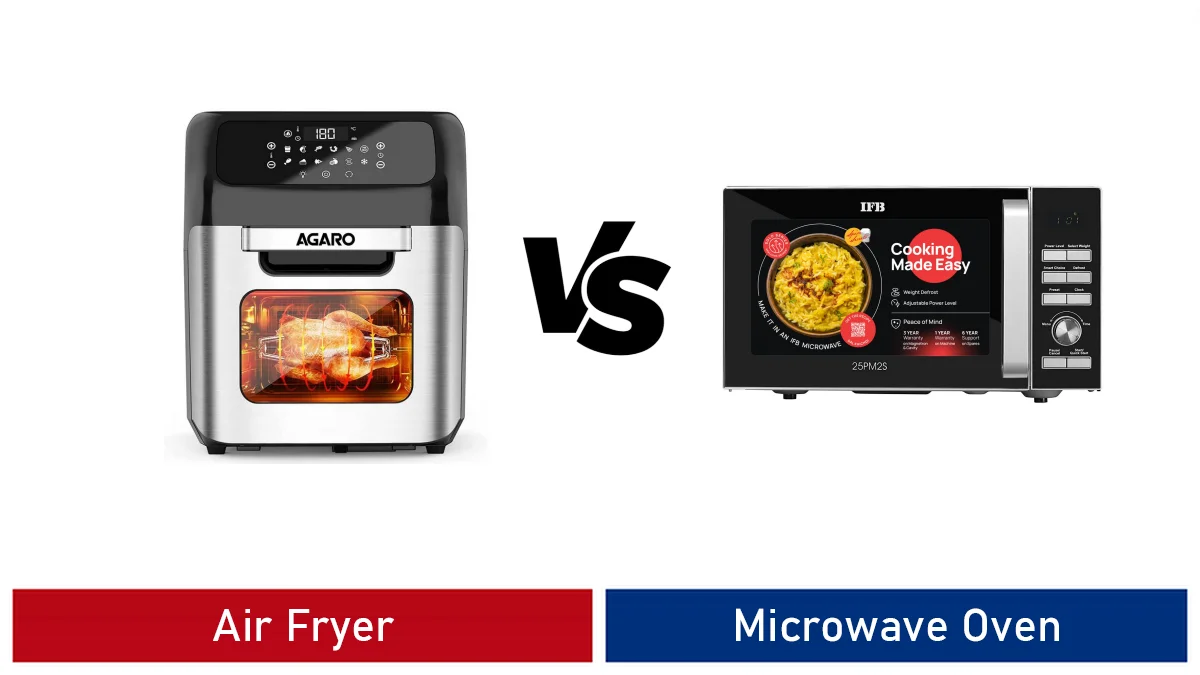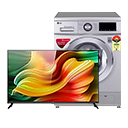
Air Fryer vs Microwave Oven – In the realm of kitchen appliances, air fryers and microwave ovens are two modern marvels that have revolutionized the way we cook and reheat food.
However, they serve distinctly different purposes and offer unique advantages.
In this comprehensive guide, we will compare air fryers and microwave ovens, helping you understand their functions, benefits, and which one might be the right addition to your kitchen.
Contents
- 1. Understanding Air Fryers
- 2. Understanding Microwave Ovens
- 3. Comparing Cooking Methods
- 4. Cooking Time and Efficiency
- 5. Versatility and Cooking Options
- 6. Health Considerations
- 7. Convenience and Ease of Use
- 8. Cost Comparison
- 9. Space and Kitchen Considerations
- 10. User Preferences and Recipes
- Conclusion
- Air Fryer vs Microwave Oven FAQs
1. Understanding Air Fryers
- Colour: Silver
- Capacity: 12 litres
- Control Method: Touch
- Material: Stainless Steel
1.1 How Air Fryers Work
Air fryers are countertop appliances that use a powerful convection fan to circulate hot air around the food.
This process creates a crispy outer layer similar to deep-frying but with significantly less oil. Here’s a closer look at the key aspects of air fryers:
1.2 Benefits of Air Fryers
- Healthier Cooking: Air fryers allow you to enjoy the crispy texture of fried food without the excessive oil. They use up to 80% less oil compared to traditional deep frying, making meals healthier.
- Versatile Cooking: Air fryers can do more than just fry. They excel at baking, roasting, grilling, and even reheating leftovers, giving you a wide range of cooking options in a single appliance.
- Time Efficiency: Air fryers preheat quickly and cook food faster than conventional ovens. They are perfect for busy individuals looking to prepare meals swiftly.
- Energy Efficiency: They consume less energy than traditional ovens, making them an eco-friendly choice while reducing your electricity bills.
- Easy Cleanup: Air fryer baskets are typically non-stick and dishwasher safe, making cleanup a breeze.
1.3 Types and Sizes
Air fryers come in various sizes, from compact models suitable for single servings to larger ones for families. Table 1 provides an overview of the common types and sizes available:
Table 1: Common Air Fryer Types and Sizes
| Type | Capacity | Ideal for |
|---|---|---|
| Compact Air Fryer | 1-2 quarts | Snacks, appetizers, and small meals |
| Standard Air Fryer | 3-5 quarts | Small to medium-sized families |
| XL/XXL Air Fryer | 6-16 quarts | Large families and batch cooking |
| Toaster Oven Style Air Fryer | Varies (approximately 20L) | Multifunctional cooking and baking |
2. Understanding Microwave Ovens
- Colour: Black
- Capacity: 30 litres
- Material: Metal
- Installation Type: Countertop
2.1 How Microwave Ovens Work
Microwave ovens use electromagnetic waves to heat food by exciting water molecules within it.
This rapid heating process makes them ideal for reheating leftovers and cooking certain dishes. Let’s explore the key aspects of microwave ovens:
2.2 Benefits of Microwave Ovens
- Speedy Reheating: Microwaves excel at quickly reheating cold or frozen food items, making them a time-saver.
- Even Heating: Microwaves distribute heat evenly, preventing hotspots in your food.
- Preserving Nutrients: Microwave cooking can preserve more nutrients in vegetables compared to other cooking methods.
- Minimal Oil Usage: Microwaves don’t require oil for cooking, making them a healthier option for certain dishes.
- Space Efficiency: Microwave ovens are typically compact and suitable for kitchens with limited counter space.
2.3 Types and Sizes
Microwave ovens come in various types and sizes, from countertop models to built-in units. Table 2 provides an overview of common microwave oven types and their ideal uses:
Table 2: Common Microwave Oven Types and Sizes
| Type | Size (Cubic Feet) | Ideal for |
|---|---|---|
| Countertop Microwave Oven | 0.5-2.2 cu. ft. | Small to medium-sized kitchens |
| Over-the-Range Microwave Oven | 1.5-2.2 cu. ft. | Kitchen with limited counter space |
| Built-in Microwave Oven | Varies | Seamless integration into kitchen cabinets |
3. Comparing Cooking Methods
3.1 Cooking Methods in Air Fryers
Air fryers use rapid hot air circulation to cook food. This method is particularly suitable for dishes that benefit from a crispy texture, such as:
- French Fries: Air fryers can produce crispy and golden fries with minimal oil.
- Chicken Wings: They achieve the perfect level of crispiness without deep-frying.
- Vegetables: Air-fried vegetables retain their crispness while becoming tender inside.
- Baking: Air fryers excel in baking tasks, from muffins to small cakes.
3.2 Cooking Methods in Microwave Ovens
Microwave ovens, on the other hand, use microwave radiation to heat food from the inside out. They are best suited for:
- Reheating: Microwaves are unbeatable when it comes to reheating leftovers quickly and evenly.
- Defrosting: They efficiently thaw frozen foods, ensuring even defrosting.
- Steaming: Microwaves can steam vegetables and seafood, preserving their natural flavors.
- Cooking Convenience Foods: Ready-to-eat meals and microwaveable snacks are designed for microwave use.
It’s important to note that while microwave ovens are exceptional for reheating and certain cooking tasks, they do not produce the same crispy texture as air fryers.
4. Cooking Time and Efficiency
4.1 Cooking Time in Air Fryers
Air fryers are known for their speed. They preheat rapidly, and their powerful fans circulate hot air efficiently.
As a result, air fryers can cook food faster than traditional ovens. For instance, a batch of crispy chicken wings takes about 20-25 minutes in an air fryer compared to 45-60 minutes in a conventional oven.
4.2 Cooking Time in Microwave Ovens
Microwave ovens are unbeatable in terms of reheating speed. They can warm up a plate of leftovers in a matter of minutes.
However, when it comes to cooking raw food, microwaves may take longer than air fryers.
For example, while a microwave can steam vegetables quickly, roasting them in an air fryer might yield a crispier result in a shorter time.
In terms of energy efficiency, both appliances have their advantages. Air fryers consume less energy compared to conventional ovens, making them an efficient choice for small to medium-sized meals.
Microwave ovens, on the other hand, excel at reheating and use minimal energy for quick tasks.
5. Versatility and Cooking Options
5.1 Versatility of Air Fryers
Air fryers are incredibly versatile appliances. They can handle a wide range of cooking methods, such as:
- Frying: Achieve crispy results with minimal oil.
- Baking: Prepare muffins, brownies, and even bread.
- Roasting: Roast vegetables and meats to perfection.
- Grilling: Create grill marks on meat and vegetables.
- Reheating: Quickly reheat leftovers without sacrificing texture.
5.2 Cooking Options in Microwave Ovens
Microwave ovens are less versatile when it comes to cooking techniques but excel in their specialized functions:
- Reheating: Microwave ovens are the go-to for reheating meals.
- Steaming: Steam vegetables, seafood, and rice.
- Defrosting: Safely and quickly defrost frozen items.
- Cooking Convenience Foods: Easily prepare frozen meals and snacks.
Air fryers offer more cooking options and are better suited for those who enjoy experimenting with various recipes and cooking methods.
6. Health Considerations
6.1 Health Benefits of Air Fryers
Air fryers have gained popularity for their potential health benefits:
- Reduced Oil Usage: Air frying uses significantly less oil compared to traditional deep frying, reducing overall calorie and fat intake.
- Crispy Texture: They achieve a crispy texture without the excess oil, making fried foods more enjoyable while being healthier.
- Less Acrylamide Formation: Air frying can produce fewer harmful compounds like acrylamide compared to deep frying.
However, it’s essential to remember that the health benefits depend on the ingredients and recipes you use.
Air frying won’t make unhealthy foods healthy, but it can make them less unhealthy.
6.2 Health Considerations with Microwave Ovens
Microwave ovens, by design, do not require the use of oil for cooking. This can be advantageous when you’re looking to minimize oil consumption in your meals.
Additionally, microwave cooking can retain more nutrients in vegetables compared to methods like boiling.
7. Convenience and Ease of Use
7.1 Convenience of Air Fryers
Air fryers are praised for their ease of use:
- Preheating: They preheat quickly, eliminating the need for prolonged waiting.
- Temperature Control: Most air fryers offer precise temperature control for tailored cooking.
- Cooking Alerts: Many models have timers and alerts to prevent overcooking.
7.2 Convenience of Microwave Ovens
Microwave ovens are renowned for their simplicity:
- One-Touch Cooking: Most microwaves have one-touch buttons for common tasks like reheating beverages, popcorn, or frozen dinners.
- Quick Reheating: Their speed makes them ideal for busy individuals.
- Uniform Heating: Microwaves ensure even heating without the need for stirring.
Both appliances are user-friendly, but the choice often comes down to the specific cooking tasks you prioritize.
8. Cost Comparison
8.1 Initial Cost of Air Fryers
The initial cost of an air fryer varies depending on its size and features. Compact models can be quite affordable, starting at around $40, while larger, multifunctional models can range from $100 to $300.
8.2 Operating Costs of Air Fryers
Air fryers are energy-efficient and use less electricity compared to conventional ovens. This means lower energy bills over time.
Additionally, they require less oil for cooking, reducing ongoing expenses.
8.3 Initial Cost of Microwave Ovens
Microwave ovens are generally more budget-friendly. Countertop models can be found for as low as $50 (around ₹4000), while over-the-range or built-in models can range from $200 (around ₹15000) to $1,000 (around ₹80000).
8.4 Operating Costs of Microwave Ovens
Microwave ovens are also energy-efficient, but they have minimal ongoing costs since they don’t require oil for cooking.
However, their reheating speed can contribute to a slight increase in electricity bills if used frequently.
In terms of cost, microwave ovens often have the advantage of affordability, both in terms of initial purchase and long-term operation.
9. Space and Kitchen Considerations
9.1 Space Considerations for Air Fryers
Air fryers, especially the larger models, can take up a significant amount of counter space. If your kitchen has limited counter space, consider the size of the air fryer and whether it can fit comfortably in your kitchen layout.
9.2 Space Considerations for Microwave Ovens
Microwave ovens are known for their space-saving design. Countertop models are compact and suitable for kitchens with limited counter space.
Over-the-range and built-in models are integrated into cabinetry, saving even more space.
10. User Preferences and Recipes
10.1 User Preferences
Choosing between an air fryer and a microwave oven often comes down to personal preferences and cooking habits.
Consider your cooking style, the types of dishes you frequently prepare, and your desire for versatility when making your decision.
10.2 Recipes and Cooking Tips
Each appliance has its own set of recipes and cooking tips. Air fryers have a wide range of recipes for crispy dishes, while microwave ovens have a plethora of recipes designed for quick and efficient cooking and reheating.
Conclusion
In the battle of “Air Fryer vs. Microwave Oven,” the winner depends on your specific needs and cooking preferences.
Air fryers are the go-to choice for those seeking healthier alternatives to deep-fried foods and enjoy experimenting with versatile cooking methods.
Microwave ovens, on the other hand, excel in quick reheating and convenient cooking.
Ultimately, the ideal kitchen appliance is the one that aligns with your culinary goals and lifestyle.
Consider your cooking habits, available space, and desired cooking options when making your decision.
Whichever you choose, both appliances have their place in modern kitchens, simplifying and enhancing the way we cook and enjoy our meals.
Air Fryer vs Microwave Oven FAQs
What's the main difference between an air fryer and a microwave oven?
The main difference between an air fryer and a microwave oven is their cooking method.
Air fryers use convection technology and a heating element to cook food by circulating hot air, while microwave ovens use microwave radiation to heat food from the inside.
These different cooking methods affect the texture and results of your dishes.
Which appliance is better for reheating leftovers, an air fryer or a microwave oven?
Microwave ovens are typically better for reheating leftovers because they heat food quickly and evenly, ensuring that it retains its original texture and moisture.
Air fryers are not ideal for reheating as they can further crisp up food, which may not be suitable for all dishes.
Can an air fryer replace a microwave oven for cooking and heating?
An air fryer can replace a microwave oven for some cooking tasks, especially when it comes to baking, roasting, and air frying dishes.
However, it may not be as efficient for quick heating or reheating of liquids and certain types of dishes, which are better suited to a microwave oven.
Can a microwave oven be used for air frying and crisping like an air fryer?
No, microwave ovens are not designed for air frying or crisping.
They lack the convection and heating element features that air fryers have, which are essential for achieving the crispy texture associated with air frying.
Which appliance is more energy-efficient, an air fryer or a microwave oven?
Microwave ovens are generally more energy-efficient for reheating and cooking tasks that require less time.
Air fryers can consume more power due to their longer cooking times and the need to preheat.
However, the energy efficiency of both appliances can vary depending on usage and the specific models.
|
Related Tags
air fryer vs microwave cancer, air fryer vs microwave health, Air fryer vs microwave oven which is better, Air fryer vs microwave oven vs ninja, Air fryer vs microwave oven vs air fryer, air fryer vs microwave convection, air fryer vs microwave radiation, air fryer vs otg vs microwave
Last update on 2024-05-20 at 17:09 / Affiliate links / Images from Amazon Product Advertising API













